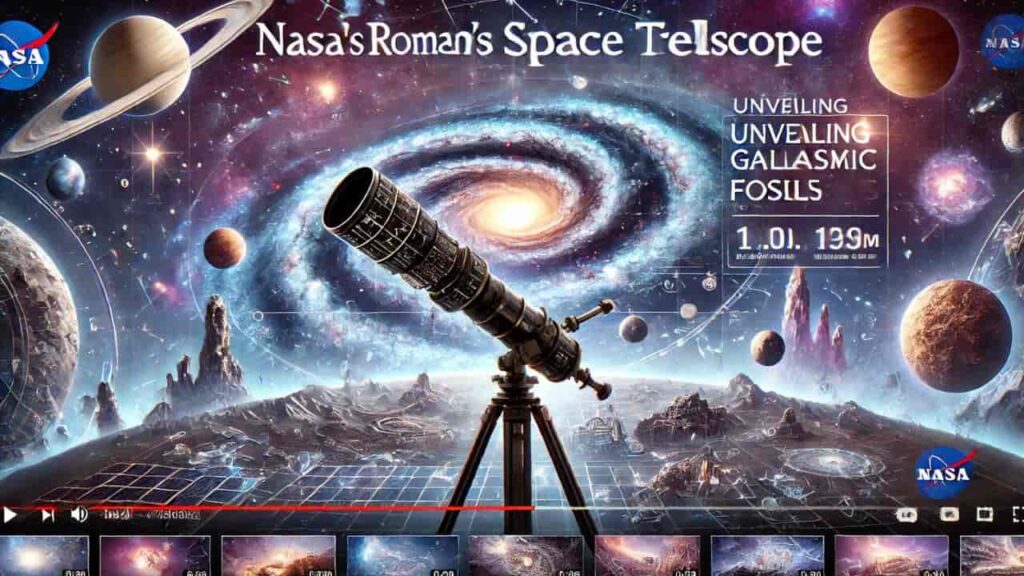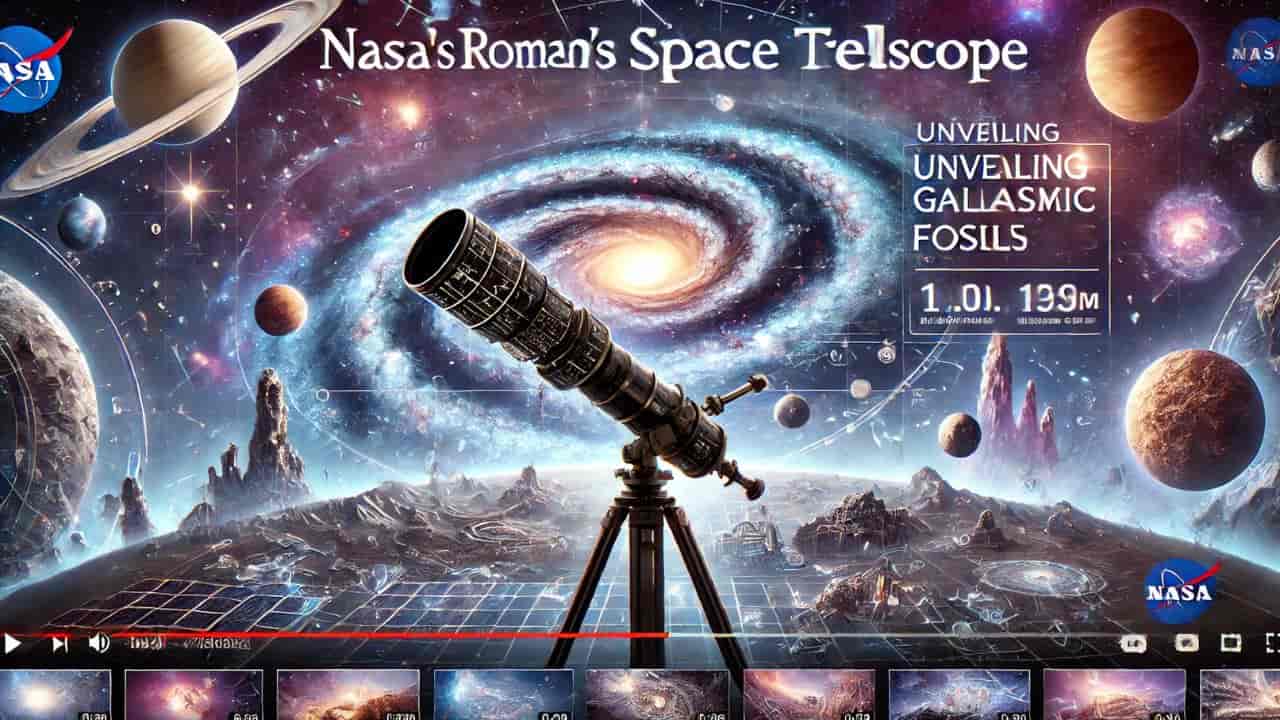NASA Roman Space Telescope, galactic fossils, galaxy formation, dark matter, RINGS survey, Nancy Grace Roman Telescope, ultra-faint dwarf galaxies, galactic archaeology, space exploration, astronomy
Discover how NASA’s upcoming Nancy Grace Roman Space Telescope is set to revolutionize our understanding of galaxy formation and dark matter. Learn about the RINGS survey and how this powerful telescope will uncover the galactic fossils that reveal the universe’s hidden history.

NASA’s Roman Space Telescope: Exploring the Galactic Fossils of the Universe
The universe is a vast, ever-changing expanse where galaxies continuously evolve over millions and billions of years. This process includes galaxies merging, shifting in appearance, and interacting in a cosmic dance. However, because these changes occur over such extended periods, humanity can only capture fleeting glimpses of these events through telescopic observations. Telescopes, as remarkable as they are, provide only snapshots of these dynamic processes within the short span of a human lifetime. Despite these limitations, galaxies leave behind vital clues that offer insights into their history and formation.
NASA’s upcoming Nancy Grace Roman Space Telescope is poised to revolutionize our understanding of these cosmic events by investigating the “fossils” of galaxy formation. With its high-resolution imaging capabilities, the Roman Space Telescope will allow astronomers to delve deep into the past of galaxies in the nearby universe, uncovering the remnants of their evolutionary history. This ambitious endeavor holds the promise of shedding new light on the processes that have shaped the cosmos.
Galactic Fossils: Tracing the History of the Universe
Galaxies, much like living organisms on Earth, leave behind traces of their evolution. These remnants, often referred to as galactic fossils, are ancient stars and stellar structures that provide a window into the past. These structures hold valuable information about the galaxy’s formation and evolution, including the chemical composition of the galaxy at the time these stars were born. By studying these fossils, scientists can piece together the complex puzzle of how galaxies have evolved over billions of years.
One of the leading voices in this area of research is Robyn Sanderson, the deputy principal investigator of the RINGS (Roman Infrared Nearby Galaxies Survey) project at the University of Pennsylvania in Philadelphia. Sanderson likens the process of studying stellar structures in galaxies to an archaeological excavation. Just as paleontologists sift through layers of rock to reconstruct the skeletons of ancient creatures, astronomers analyze the distribution and composition of stars to understand the history of galaxies.
The Roman Space Telescope’s high resolution will enable scientists to identify and study these galactic fossils in unprecedented detail. The telescope’s capabilities will allow researchers to examine large-scale structures, such as tidal tails and stellar streams, which are remnants of past galaxy mergers. These structures serve as cosmic markers, providing clues about a galaxy’s merger history and the interactions that have shaped it over time.
The RINGS Survey: A Glimpse into Galactic History
The RINGS project, although still a preliminary concept, represents a groundbreaking approach to studying galactic fossils. Through this survey, astronomers hope to collect high-resolution images of nearby galaxies, revealing the intricate details of their structure and composition. The data gathered by RINGS will be made publicly available, allowing the broader astronomy community to explore and analyze these observations once the Roman Space Telescope begins its mission.
Roman is uniquely equipped for this task due to its combination of high resolution and a wide field of view. While NASA’s Hubble Space Telescope has provided remarkable images of the universe, its narrow field of view limits its ability to capture large-scale structures in a single observation. In contrast, Roman’s wide field of view, which is 200 times larger than Hubble’s in the infrared spectrum, makes it an ideal tool for surveying the sky and capturing the full extent of these galactic fossils.
Dark Matter: Unveiling the Universe’s Hidden Substance
In addition to studying galactic fossils, the Roman Space Telescope will play a crucial role in investigating one of the most mysterious substances in the universe: dark matter. Dark matter is an invisible form of matter that makes up the majority of a galaxy’s mass. Despite its prevalence, dark matter remains elusive and unobservable through conventional means. However, its presence can be inferred through its gravitational effects on visible matter.
One of the key areas of focus for dark matter research with Roman will be ultra-faint dwarf galaxies. These galaxies are of particular interest because they are dominated by dark matter, with very little normal matter to facilitate star formation. As a result, ultra-faint dwarf galaxies can be considered almost pure blobs of dark matter, providing a unique opportunity to study this enigmatic substance.
Raja GuhaThakurta of the University of California, Santa Cruz, emphasizes the importance of ultra-faint dwarf galaxies in dark matter research. According to GuhaThakurta, these galaxies are ideal candidates for testing dark matter theories due to their dark matter-dominated nature. Roman’s large field of view and high resolution will enable astronomers to observe these ultra-faint galaxies and gather data that could help unravel the mysteries of dark matter.
However, dark matter research is not limited to ultra-faint galaxies. The halos of stars that surround average-sized galaxies also hold valuable clues about the distribution of dark matter. These galactic halos are vast, often extending 15 to 20 times the size of the galaxy itself. Current telescopes struggle to observe these halos efficiently due to their immense size. Roman’s capabilities will allow astronomers to conduct comprehensive surveys of galactic halos, providing a deeper understanding of dark matter’s role in the universe.
At present, the only fully resolved galactic halos are those of the Milky Way and Andromeda, the galaxy nearest to us. Ben Williams, the principal investigator of RINGS at the University of Washington in Seattle, explains how Roman will expand our knowledge in this area. With Roman’s power, scientists will be able to obtain reliable measurements of over 100 fully resolved galaxies, offering a much broader sample for studying dark matter and galactic evolution.
Roman’s Impact on Galactic Understanding
The launch of the Roman Space Telescope, expected by May 2027, is anticipated to fundamentally transform our understanding of galaxies and their evolution. By studying galaxies similar in size and age to the Milky Way, Roman will provide insights into the processes that have shaped our own galaxy and the broader universe. The RINGS survey, if approved, will be a key component of this mission, offering a detailed exploration of the nearby universe and its galactic fossils.
While the Milky Way is relatively easy to study due to its proximity, capturing a complete picture of our galaxy and its surrounding halo remains a challenge. Roman’s capabilities will allow scientists to study galaxies similar to the Milky Way, providing a valuable comparison that can enhance our understanding of how our galaxy has evolved over time.
The Roman Space Telescope is managed by NASA’s Goddard Space Flight Center in Greenbelt, Maryland, with participation from NASA’s Jet Propulsion Laboratory and Caltech/IPAC in Southern California, the Space Telescope Science Institute in Baltimore, and a diverse team of scientists from various research institutions. The telescope’s primary industrial partners include BAE Systems, Inc., L3Harris Technologies, and Teledyne Scientific & Imaging.
Conclusion
NASA’s Nancy Grace Roman Space Telescope represents a significant leap forward in our ability to explore the universe. Through its high-resolution imaging and wide field of view, Roman will uncover the galactic fossils that hold the secrets of galaxy formation and evolution. The RINGS survey, while still a preliminary concept, offers a glimpse into the potential of Roman to transform our understanding of the cosmos.
In addition to its impact on galactic archaeology, Roman will also contribute to our knowledge of dark matter, the invisible substance that makes up most of the universe’s mass. By studying ultra-faint dwarf galaxies and galactic halos, Roman will provide crucial data that could help solve one of the greatest mysteries in astrophysics.
As we look forward to the launch of the Roman Space Telescope, we anticipate a new era of discovery that will deepen our understanding of the universe and our place within it. Through its innovative design and advanced capabilities, Roman is set to become a cornerstone of astronomical research, offering insights that will resonate for generations to come.
Read More
- NASA and Sierra Space Dream Chaser Arrives in Florida for Launch Prep
- NASA Webb Telescope Hints at Possible Atmosphere Surrounding Rocky Exoplanet
- Curious Asteroid Selam, Spotted by NASA’s Lucy Spacecraft, Is a Cosmic Toddler
- SpaceXs New Falcon 9 Booster Successfully Launches 22 Starlink Satellites Boosting Global Connectivity










